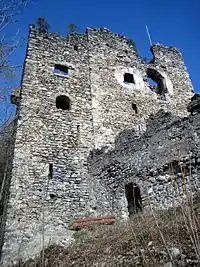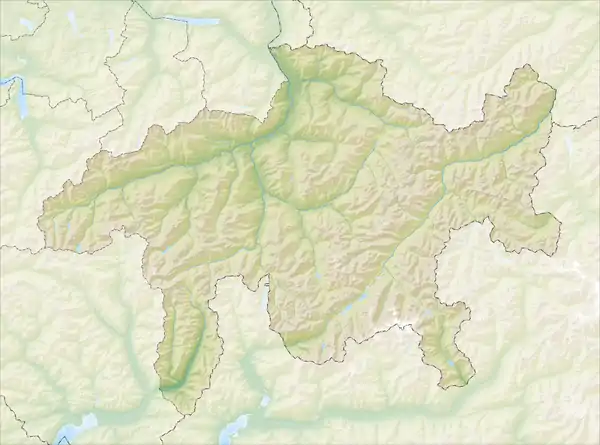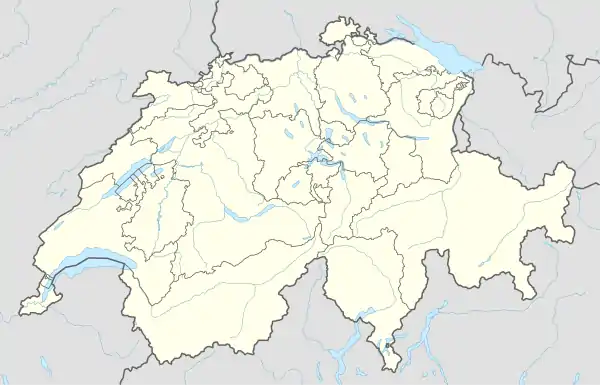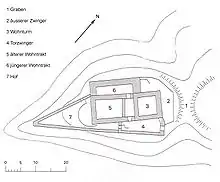Neu-Aspermont Castle
Neu-Aspermont Castle is a ruined castle in the municipality of Jenins of the Canton of Graubünden in Switzerland. It is a Swiss heritage site of national significance.[1]
| Neu-Aspermont Castle | |
|---|---|
Burg Neu-Aspermont | |
| Jenins | |
 Neu-Aspermont Castle | |
 Neu-Aspermont Castle  Neu-Aspermont Castle | |
| Coordinates | 47.003243°N 9.565202°E |
| Site information | |
| Owner | Canton of Graubünden |
| Open to the public | yes |
| Condition | ruined |
| Site history | |
| Built | c. 1235 |
| Built by | Lords of Aspermont |
| Materials | stone |
History
The Lords of Aspermont first appear in the historical record in 1120 as ministerialis or unfree knights in service to the Bishop of Chur, living at their castle Alt-Aspermont near Trimmis. Over the following centuries, they rose to become one of the main noble families in the region, with ties to the powerful Hohenstaufen family. In the early 13th century they built Neu-Aspermont north-east of the village of Jenins.[2] The oldest wooden beams in the castle have been dated to 1235.[3] The castle was built with a large tower and a separate palas west of the tower.
In the late 13th century, the bishop of Chur (and the Lords of Aspermont) and the Freiherr of Vaz quarreled over Jenins. The conflict was resolved in 1284 through arbitration. In the agreement they were ordered to share the castle, but neither were allowed to expand the fortifications. However, in 1299, a second arbitration ordered Johann of Vaz to demolish an addition to the castle. It is unclear what happened next or whether he ever demolished the structure, but soon thereafter the Lords of Aspermont appear to be the only nobles at Jenins or Neu-Aspermont Castle. In the 14th century the Aspermont family began divesting their holdings in the region. In 1348 they sold their holdings in the Prättigau and two years later Rudolf von Rankweil acquired the castle. In 1376 they gave up their rights to be buried in Chur Cathedral to the Lords of Greifensee and moved to Dornbirn, using the name Aspermont in Rhomberg.[2]
The castle then passed through several owners until it was acquired in 1468 by Diepold von Schlandersberg. During the 1499 Swabian War the Schlandersberg family supported the Habsburg king against the local Three Leagues. On 14 February 1499 League troops attacked and captured Maienfeld and then marched on Neu-Aspermont. In the following days they captured and partially destroyed the castle. The castle was rebuilt soon after the war, with the ring wall and the upper portion of the tower dating from this 16th century construction. The Schlandersberg continued to inhabit the castle until 1522.[2]
In 1522 the castle was inherited by Josua von Beroldingen, but a few years later was owned by Johann von Marmels. In 1536 the Three Leagues took over the castle and sold it to private owners. Over the following century and a half it passed through a number of owners. In the late 17th century it was abandoned and began to fall into ruin. In 1862 Ernest von Rhomberg was able to document his descent from the Lords of Aspermont and the Swiss Confederation allowed him to purchase the ruins for CHF 500 In 2001 the Rhomberg-Aspermont family and the Neuaspermont Castle Association began a cleaning and repair project on the ruins.[2]
Castle site

The castle is built on a rocky spur above the village of Jenins. The castle is separated from the mountain side by a dry moat. South-west of the moat is the large square six or seven story tower. The original high entrance was on the third floor of the south-west side. After it was partly destroyed in 1499, the upper stories were either rebuilt or added. Keyhole and square windows mark the early 16th century construction.[4] Baroque frescoes in black and white are still visible on the walls. South-west of the tower is the remains of the medieval residential tract or palas along with additional housing which was probably added in the 16th century. A wall enclosed the southern end of the spur, forming a courtyard behind the palas. East of the tower was the gatehouse and wall that ran along the dry moat.[5]
Gallery
 Southwest side of the tower
Southwest side of the tower Neu-Aspermont above the village of Jenins
Neu-Aspermont above the village of Jenins Old and new parts of the palas, new on the left
Old and new parts of the palas, new on the left Main gate
Main gate View of the castle in 1906
View of the castle in 1906
See also
References
- "Kantonsliste A-Objekte". KGS Inventar (in German). Federal Office of Civil Protection. 2009. Archived from the original on 28 June 2010. Retrieved 25 April 2011.
- "Burg Neu_Aspermont". www.burgenwelt.ch. Retrieved 8 June 2017.
- "Burgruine Neu_Aspermont". Federal Office of Civil Protection. Retrieved 8 June 2017.
- Neu_Aspermont in German, French and Italian in the online Historical Dictionary of Switzerland.
- "Schloss Neu_Aspermont". www.swisscastles.ch. Retrieved 8 June 2017.
| Wikimedia Commons has media related to Neu-Aspermont Castle. |